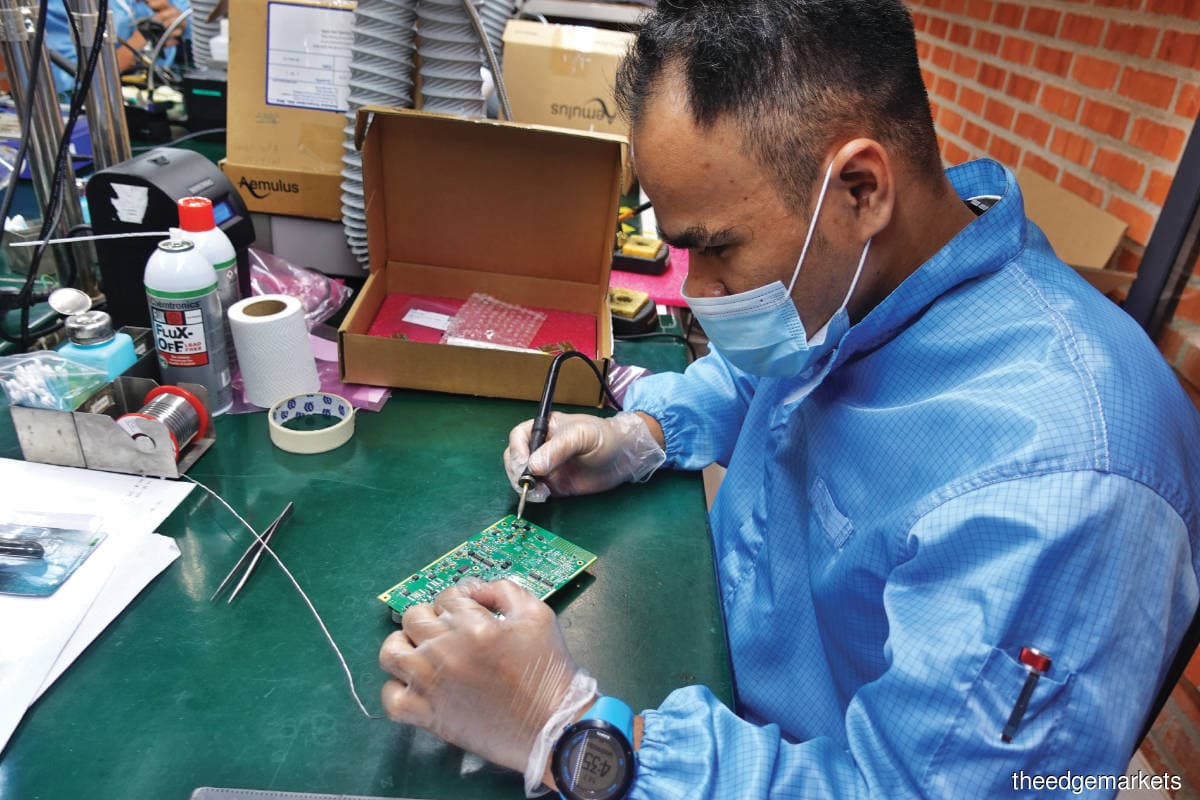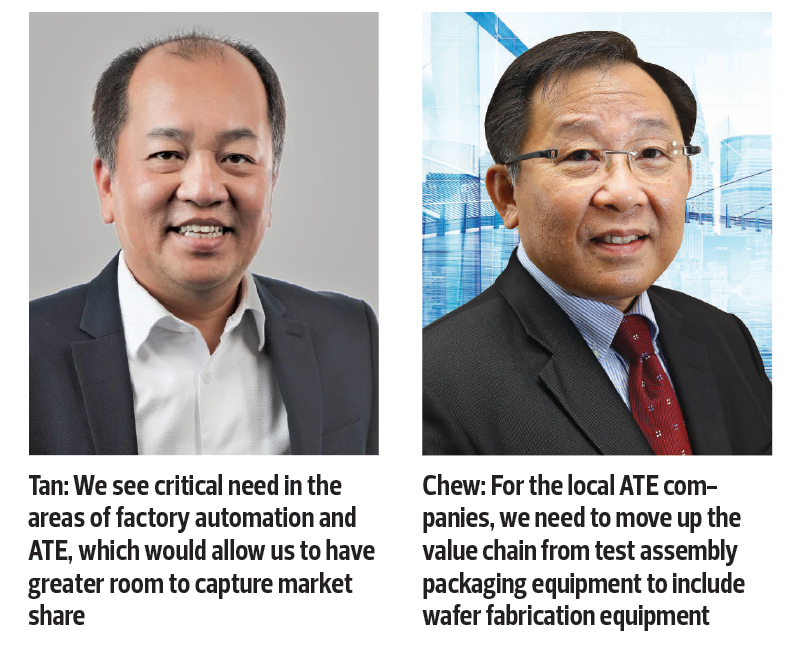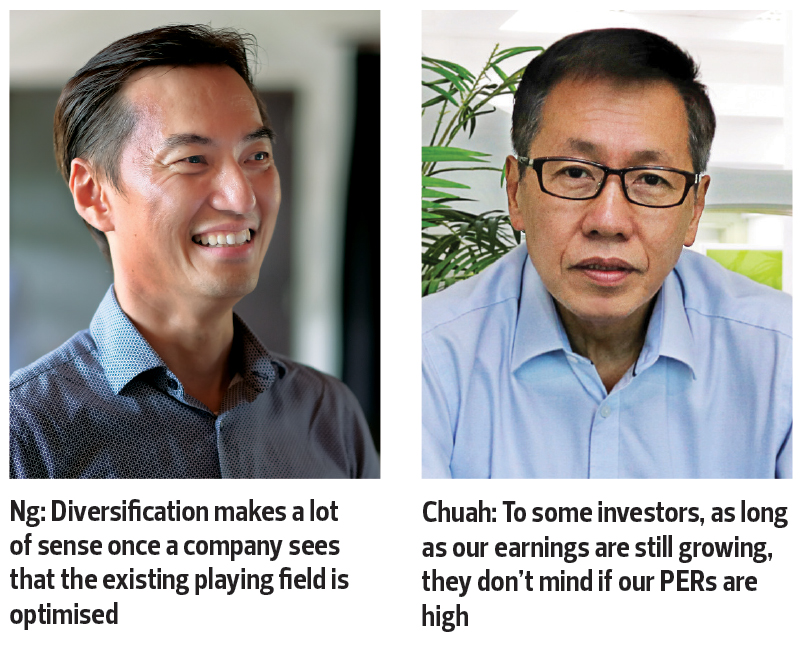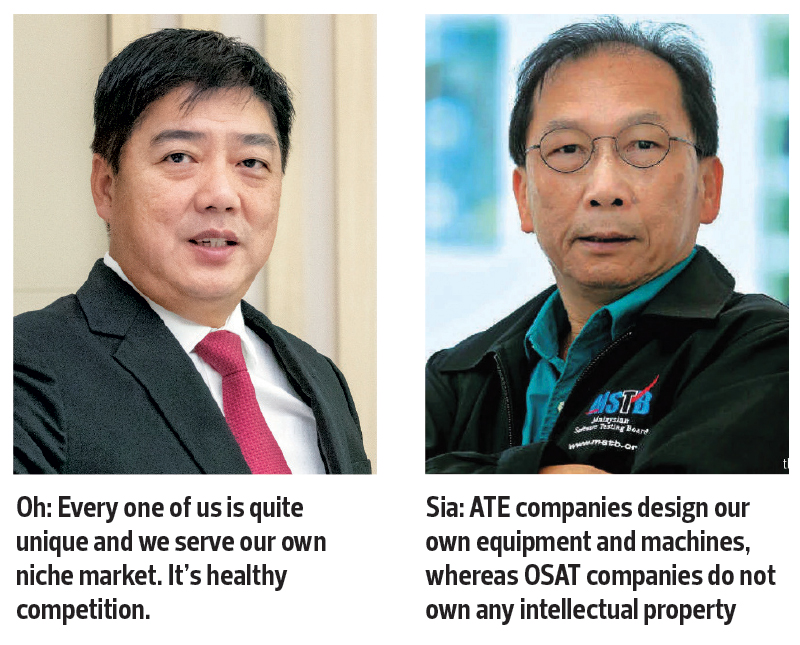
This article first appeared in The Edge Malaysia Weekly on September 13, 2021 - September 19, 2021
OVER the past few decades, the Malaysian semiconductor scene has largely been dominated by the labour-intensive outsourced semiconductor assembly and test (OSAT) companies.
Companies like Inari Amertron Bhd, Malaysian Pacific Industries Bhd (MPI), Unisem (M) Bhd, Globetronics Technology Bhd and KESM Industries Bhd were established to provide outsourced services such as assembly, packaging and testing to multinational corporations (MNCs) that include Advanced Micro Devices, Analog Devices, Agilent Technologies (formerly Hewlett Packard), Broadcom, Lumileds, Jabil, Renesas, Western Digital, Intel, Dell, Osram, Infineon and Micron. These foreign companies set up operations in Malaysia, most of them in Penang, with some starting as early as the 1970s.
The semiconductor boom, driven by these MNCs and OSAT companies, in turn created the need for automated test equipment (ATE) manufacturers and automation houses, which generated high-value jobs for engineers and technicians.
As the world moves into the Fourth Industrial Revolution (IR4.0) and artificial intelligence (AI) — which will see more manual and tedious processes across various industries being automated or digitised using smart machines with AI and Big Data analytics — the semiconductor and manufacturing sectors need ATE and factory automation solutions (FAS) more than ever to stay competitive.
These changes have contributed to the rise of ATE makers, which have largely outperformed the OSAT companies in terms of share price.
Locally-listed ATE makers — namely ViTrox Corporation Bhd, Greatech Technology Bhd, Pentamaster Corp Bhd, Mi Technovation Bhd, QES Group Bhd, Aemulus Holdings Bhd, MMS Ventures Bhd (MMSV), Elsoft Research Bhd and VisDynamics Holdings Bhd — are among the beneficiaries of these major trends.
While the profitability of these ATE firms may not be as high as that of OSAT companies, their market capitalisations are actually comparable to those of the latter. In other words, investors are willing to pay a premium for ATE stocks.
For perspective, about 10 years ago, some OSAT companies already had a market capitalisation of about RM1 billion each, whereas that of most ATE companies was less than RM100 million.
Today, the combined market capitalisation of the Big Four ATE makers — ViTrox, Greatech, Pentamaster and MI Technovation — is RM26 billion, catching up with the Big Four OSAT — Inari, MPI, Unisem and Globetronics — which have a combined market value of RM30 billion.
And thanks to the strong share price performance of ATE companies in recent years, the founders of ViTrox, Greatech, and MI Technovation are now among the richest persons in Malaysia.
So, what does the future hold for the ATE manufacturers? What are the opportunities and challenges awaiting them in the coming years?
Captains of industry The Edge spoke to see Malaysia as having enormous potential to become the regional hub for advanced technology equipment and high-tech automation, given the country’s strong local supply chain and talent pool, as well as its years of experience in this space.
Moreover, with a strong local equipment technology industry, other industries such as OSAT, electronics manufacturing services (EMS) and electrical and electronics (E&E) will become more competitive in the global arena as they will be equipped with more local state-of-the art and cost-effective equipment, and become less dependent on foreign labour and technology.
MNCs a double-edged sword?
Over the years, the MNCs, and for that matter, the local tech players and OSAT companies, have been actively expanding or making greenfield investments in the country, especially in Penang.
On one hand, the MNCs bring in more businesses for local equipment players when they develop the local supply chain. On the other hand, some argue that there is the possible risk of the MNCs displacing local businesses, discouraging entrepreneurship and competing for local talents.
In an interview with The Edge in June, Malaysia Semiconductor Industry Association (MSIA) president Datuk Seri Wong Siew Hai highlighted the “Inari waterfall effect”. According to him, Inari had purchased more than RM2.5 billion worth of equipment from local companies over the last five years. “And that’s just Inari alone. There are also MNCs that are doing the same, which benefits a lot of local companies and they now have a chance to go global,” he said.
With more MNCs investing in Penang, Greatech CEO Tan Eng Kee is of the view that local players will benefit in terms of technology, business model and upskilling of local talent.
“In the long run, this will benefit the country, not the other way round. I think the waterfall effect benefits the locals, not just Greatech, but other small and medium enterprises as well. Penang holds a lot of industries in its investment, especially in semiconductors, aerospace and life sciences. So, collectively, we benefit from these giants,” he says.
Automation solutions provider Greatech designs, develops and produces the system, machinery and equipment for its customers’ manufacturing processes.
Tan, who co-founded Greatech in 1997, and is now the country’s 22th richest person, reiterates that Malaysia should encourage MNCs to support local vendors by choosing locally made equipment and automation over foreign ones.
“Apart from this, Mida (Malaysian Investment Development Authority) should consider having a win-win agreement with these foreign investors to grow the local players in Malaysia. Since Malaysia offers attractive incentives to foreign investors, in return, Mida should urge foreign investors to establish a partnership programme to develop local players. These should not be an option for foreign investors but a compulsory criterion,” he suggests.
QES managing director and president Chew Ne Weng concurs that the MNCs will add value to the local manufacturing ecosystem, as Malaysian players could always learn from them, not to mention the business opportunities as well.
“MNCs relocated or expanded their operations to Malaysia primarily due to factors such as our local engineering talents, who are familiar with semiconductor or E&E-related segments, as well as lower costs of production, on top of incentives doled out by our government in the form of tax exemptions,” he explains.
Chew, however, disagrees that the MNCs might compete with or displace local OSATs or local equipment makers.
“For many years, we have been co-existing, and in fact, in some cases, we support each other to build a better eco-system that is resilient and efficient,” he stresses.
Shah Alam-based QES is a distributor and manufacturer of test, inspection and measuring equipment.
Chew, who co-founded QES in 1991, believes that the “waterfall effect” generated by local OSATs will allow local ATE makers to build more cost-effective equipment or solutions compared with foreign makers.
“Likewise, MNCs will also give opportunities to local ATE makers due to the lower costs of ownership factors. At times, we can provide a much better option as local ATE makers have a wealth of experience and we can improve certain technical abilities through much effort thrown into design and development,” he points out.
Aemulus CEO Ng Sang Beng notes that the presence of MNCs have nurtured local enterprises while encouraging the latter to look outward.
“I think it’s a positive development that Penang has once again been revived and is now becoming a magnetic influence for both local and foreign MNCs. Bear in mind that many local enterprises are already MNCs by definition. To me, deeming only FDI (foreign direct investment) as MNCs is actually an old school of thought,” he observes.
Bayan Lepas-based Aemulus is a design house that makes semiconductor testers, focusing primarily on the radio frequency (RF) and mixed-signal semiconductor test markets.
While Ng, who co-founded Aemulus in 2004, is unfazed over MNCs taking business away from local enterprises, he acknowledges that the poaching of staff by foreign firms without restrictions from local companies is a serious issue.
“I think a dialogue is necessary between local and foreign enterprises. In the end, it does no good for both parties,” he warns.
Diversification, JVs for new growth
It has not gone unnoticed that local ATE firms have been diversifying into other areas. For instance, ViTrox has ventured into precision smart farming, MI Technovation is acquiring a semiconductor materials business while Pentamaster is producing single-use medical devices. Meanwhile, QES and Aemulus are teaming up with foreign firms in a move to seek additional revenue stream.
Commenting on that, QES’ Chew says most ATE firms that are currently heavily involved in semiconductors realise that demand may wane over time.
“No business will always be up indefinitely. Therefore, we will try to plan to have more pillars of businesses that hopefully do not veer too far away from our expertise. For QES, we already have a wide base of customers spread across all industrial segments. We are trying to increase our manufacturing division by adding value to market segments besides semiconductors, such as life sciences, aerospace and possibly EMS segments,” he remarks.
Chew adds that QES’ customer base comprises MNCs and local OSATs. So far, not a single customer accounts for more than 10% of the group’s total revenue.
“For local ATE companies, we need to move up the value chain from test assembly packaging equipment to include wafer fabrication equipment. The market is much larger in that pool, dominated by very large MNCs. The wafer fabrication segment is very difficult to move in but there are pockets of opportunities. It will not be easy but I think it is worth the effort,” he says.
For that, QES has taken the initial step by embarking on a joint venture (JV) with US-based Applied Engineering through which the group could have some exposure to front-end wafer fabrication equipment or modules associated with this high technology field.
Meanwhile, Aemulus is partnering with advanced packaging equipment specialist Tangren Microtelligence Co Ltd to enter the China market. CEO Ng opines that diversification makes a lot of sense to expand to new territory once a company sees that the existing playing field is optimised.
“For us, we still have a big room to manoeuvre in the existing market segments, namely fifth generation (5G) RF, RF filters and CMOS image sensor (CIS). At the same time, since we established a scalable architecture, we don’t rule out the high possibility to move into adjacent markets. Those movements would probably need further development of 20% to 30% of what we already have, which is considerably manageable. As of now, we are exploring a few adjacent markets,” he reveals.
Greatech’s Tan says the group’s diversification primarily focuses on solar, electric vehicle (EV) batteries, life sciences and semiconductors.
“We have always been very focused on our direction and goal. Apart from factory automation and ATE, we will not explore any other area of businesses. In fact, we see critical need in the areas of factory automation and ATE, which would allow us to have a greater room to capture the market share. We are positive that this will keep us growing and expanding for the next decade,” he says.
In fact, Greatech’s building capacity will reach one million sq ft by mid-2022. “By then, we should have approximately a 1,200 headcount. With this expansion, we are ready to take on the new wave,” he says confidently.
Right growth path and healthy competition
Today, many people cannot survive without technology, and semiconductors are the backbone and main driver of technology, says MI Technovation executive director and group CEO Oh Kuang Eng. As the global semiconductor sector is anticipated to grow in the next 10 years, MI Technovation has a clear 10-year master plan.
“If you look at companies like ViTrox and MI Technovation, we are on the right growth path. I hope to see more Malaysian companies be as ambitious as ViTrox and us. I think most of the ATE manufacturers in Malaysia have put in a lot of efforts to develop our products,” he observes.
For instance, MMSV and Elsoft focus on serving the LED market, ViTrox on MVS, Aemulus on RF testers, Pentamaster on smart automation solutions and Greatech is banking on renewable energy and EV batteries.
As for MI Technovation, the group produces wafer-level chip-scale packaging sorting machines, final test handlers, assembly machines, wafer fabrication tools and testing instruments.
“The government and investors should appreciate the fact that the local ATE manufacturers are actually inventing their own products. We didn’t really cross each other’s path. It’s not like I see ViTrox is doing well, so I want to copy them, or other ATE players see that MI Technovation is doing well, and they want to copy us,” says Oh, who started the company in 2007, and is now the 41st richest man in the country.
“All of us are in the ATE industry, but we don’t compete directly. Every one of us is quite unique and we serve our own niche market. It’s healthy competition. Everyone has our own dream and roadmap. Everyone is out there to make a name for themselves,” he adds.
Aemulus’ Ng agrees. “Today, there are many successful ATE manufacturers in the country, especially Penang. We are all in the same industry, but we don’t really compete against each other. Everyone plays a slightly different role in the semiconductor supply chain,” he says.
“Some ATE companies use their systems to inspect whether or not a particular die or chip is positioned correctly before they are being sent for testing. As for Aemulus, our testers are focusing on functional tests for both front-end and back-end of semiconductor-testing processes. We want to make sure that the camera can capture the image correctly, from the optical and electronics standpoints,” Ng explains.
Pentamaster chairman Chuah Choon Bin highlights that among the ATE manufacturers, the group has the highest exposure to the medical sector.
“Looking at the technology counters in Malaysia, most of us are trading above historical price-earnings ratios (PERs) of above 50 times. Some investors don’t know what else to buy, so they buy into technology stocks. People are looking at the future and investing for potential growth,” he says.
“Generally, technology or semiconductor-related companies are making profits and still growing. To some investors, as long as our earnings are still growing, they don’t mind if our PERs (price-earnings ratios) are high. In my opinion, the semiconductor sector will not be going into recession, because the world is entering into the era of internet of things, industrial automation, 5G networks and EVs,” he adds.
Pentamaster, which has operations in Bayan Lepas and Batu Kawan, is involved in four major business segments, namely ATE, FAS, manufacturing of medical devices and warehouse automation solutions.
Chuah, who co-founded Pentamaster in 1991, remains optimistic that in the next few years, technology companies will continue to do well in terms of revenue and profits.
“I wouldn’t know how their share prices will perform, but I am very confident about their fundamentals and long-term prospects. For instance, EV will create a lot of opportunities for us in the area of power electronics component assembly and testing equipment. Technology companies will continue to grow besides relying on the smartphone segment,” he says.
“Overall, I would say the ATE stocks are still a good buy. Were it not for the travel restrictions, global chip shortage and supply chain disruption, I think the technology companies could perform even better. Today, many of us have orders, but we couldn’t deliver due to the supply chain and travel restriction issues,” says Chuah.
MMSV co-founder and CEO Sia Teik Keat points out that realistically, the revenue of ATE companies cannot be as high as those of OSAT companies, which are mass-production companies with high volumes.
“ATE companies design our own equipment and machines, whereas OSAT companies do not own any intellectual property. That is why the profit margins of OSATs have been around 15%-20%, whereas ATE companies could enjoy higher margins at 30% or even 40%, depending on our sales volume and product portfolio,” he comments.
“From what I observe, MMSV and Pentamaster are focusing on customised products, whereas ViTrox is building standard machines. Usually, the common practice is high volume, low margin; or low volume, high margin. For MMSV, about 80% of our products are customised, 10% are contract manufacturer, and the remaining 10% are standard machines. If you ask me, Pentamaster is our closest peer, although our niche is more in the LED and sensor market, as well as vision testing equipment, rather than the semiconductor sector in general,” Sia concludes.
Save by subscribing to us for your print and/or digital copy.
P/S: The Edge is also available on Apple's App Store and Android's Google Play.



